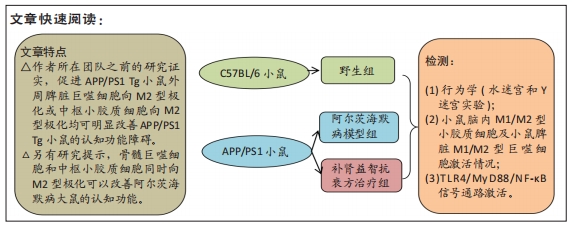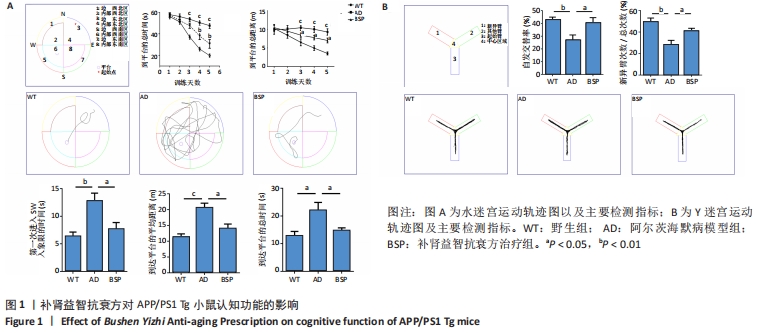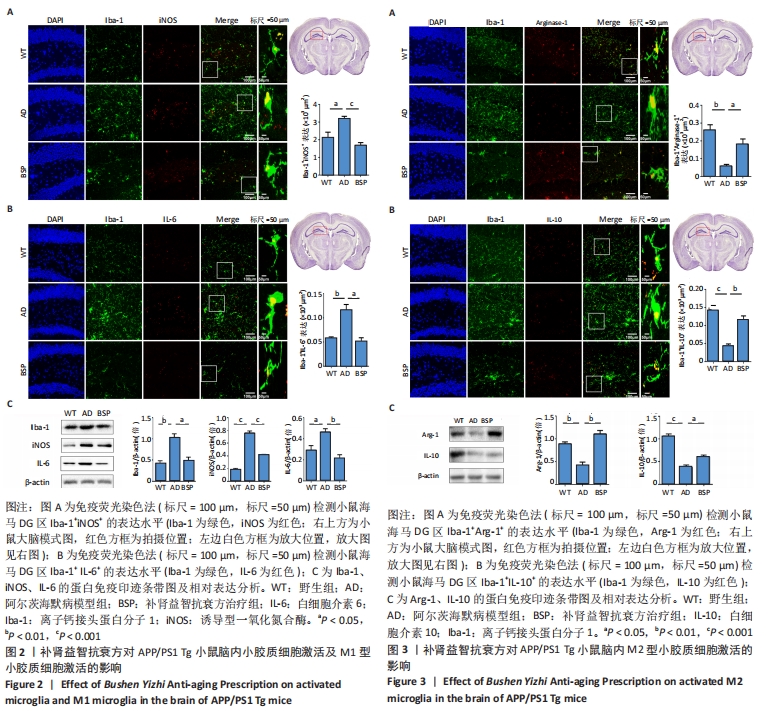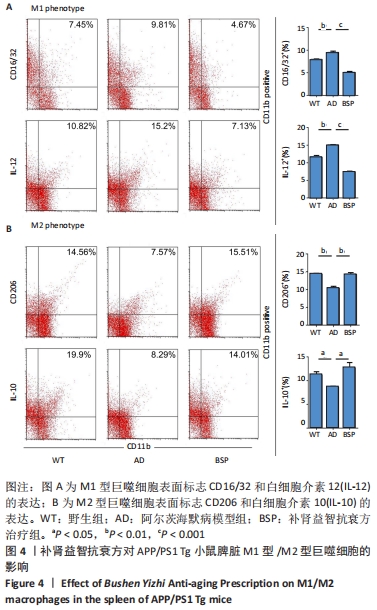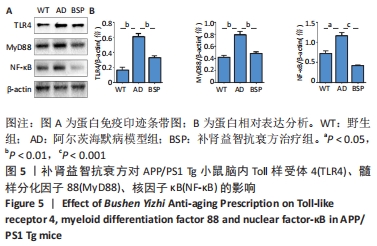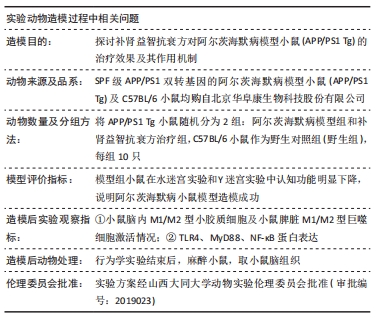[1] ARVANITAKIS Z, SHAH RC, BENNETT DA. Diagnosis and management of dementia: Review. JAMA. 2019;322:1589-1599.
[2] APOSTOLOVA LG. Alzheimer Disease. Continuum (Minneap Minn). 2016;22: 419-434.
[3] TIWARI S, ATLURI V, KAUSHIK A, et al. Alzheimer’s disease: pathogenesis, diagnostics, and therapeutics. Int J Nanomedicine. 2019;14:5541-5554.
[4] HAYES A, THAKER U, IWATSUBO T, et al. Pathological relationships between microglial cell activity and tau and amyloid β protein in patients with Alzheimer’s disease. Neurosci Lett. 2002;331:171-174.
[5] AKIYAMA H, BARGER S, BARNUM S, et al. Inflammation and Alzheimer’s disease. Neurobiol Aging. 2000;21:383-421.
[6] DIONISIO-SANTOS DA, OLSCHOWKA JA, O’BANION MK. Exploiting microglial and peripheral immune cell crosstalk to treat Alzheimer’s disease. J Neuroinflammation. 2019;16:74.
[7] WANG ZY, LIU JG, LI H, et al. Pharmacological effects of active components of Chinese herbal medicine in the treatment of Alzheimer’s Disease: A Review. Am J Chin Med. 2016;44:1525-1541.
[8] SU Y, WANG Q, WANG C, et al. The treatment of Alzheimer’s disease using Chinese medicinal plants: from disease models to potential clinical applications.J Ethnopharmacol. 2014;152:403-423.
[9] GORJI N, MOEINI R, MEMARIANI Z. Almond, hazelnut and walnut, three nuts for neuroprotection in Alzheimer’s disease: A neuropharmacological review of their bioactive constituents. Pharmacol Res. 2018;129:115-127.
[10] CUI X, WANG S, CAO H, et al. A Review: The Bioactivities and pharmacological applications of Polygonatum sibiricum polysaccharides. Molecules. 2018;23: 1170.
[11] ZHANG H, CAO Y, CHEN L, et al. A polysaccharide from Polygonatum sibiricum attenuates amyloid-β-induced neurotoxicity in PC12 cells. Carbohydr Polym. 2015;117:879-886.
[12] KUBOYAMA T, HIROTSU K, ARAI T, et al. Polygalae Radix extract prevents axonal degeneration and memory deficits in a transgenic mouse model of Alzheimer’s Disease. Front Pharmacol. 2017;8:805.
[13] 韩丽娜,范艳丽,田建文.枸杞多糖抗炎作用及其机制进展[J].现代免疫学, 2018,38(4):342-345.
[14] 李倩,高慧婕,高沁航.远志酊对脂多糖致炎小鼠抗炎活性的实验研究[J].中国医院药学杂志,2019,39(4):361-364.
[15] CHEN SQ, CAI Q, SHEN YY, et al. Age-related changes in brain metabolites and cognitive function in APP/PS1 transgenic mice. Behav Brain Res. 2012;235:1-6.
[16] LI XY, MEN WW, ZHU H, et al. Age- and brain region-specific changes of glucose metabolic disorder, learning, and memory dysfunction in early Alzheimer’s Disease assessed in APP/PS1 transgenic mice using 18F-FDG-PET. Int J Mol Sci. 2016;17:1707.
[17] LIU CY, LI YH, YU JZ, et al. Targeting the shift from M1 to M2 macrophages in experimental autoimmune encephalomyelitis mice treated with fasudil. PLoS One. 2013;8:e54841.
[18] Guo SD, Liu CY, Yu JW, et al. Nasal delivery of Fasudil-modified immune cells exhibits therapeutic potential in experimental autoimmune encephalomyelitis.CNS Neurosci Ther. 2019;25:783-795.
[19] 屈夏夏,第五永长.中药复方防治阿尔茨海默病的临床机理及研究概况[J].辽宁中医杂志,2019,46(3):653-656.
[20] LI X, CUI J, YU Y, et al. Traditional Chinese Nootropic Medicine Radix Polygalae and Its Active Constituent Onjisaponin B Reduce β-Amyloid Production and Improve Cognitive Impairments. PLoS One. 2016;11(3):e0151147.
[21] CAO S, DU J, HEI Q. Lycium barbarum polysaccharide protects against neurotoxicity via the Nrf2-HO-1 pathway. Exp Ther Med. 2017;14:4919-4927.
[22] YU MS, LEUNG SK, LAI SW, et al. Neuroprotective effects of anti-aging oriental medicine Lycium barbarum against beta-amyloid peptide neurotoxicity. Exp Gerontol. 2005;40:716-727.
[23] WANG Y, LV M, WANG T, et al. Research on mechanism of charred hawthorn on digestive through modulating “brain-gut” axis and gut flora. J Ethnopharmacol. 2019;245:112166.
[24] 尉杰忠,谷青芳,闫玉清,等.法舒地尔通过抑制脑内小胶质细胞活化并促进其M2极化而改善APP/PS1双转基因小鼠认知功能[J].细胞与分子免疫学杂志,2017,33(12):1585-1593.
[25] DU L, ZHANG Y, CHEN Y, et al. Role of microglia in neurological disorders and their potentials as a therapeutic target. Mol Neurobiol. 2017;54:7567-7584.
[26] YAO K, ZU HB. Microglial polarization: novel therapeutic mechanism against Alzheimer’s disease. Inflammopharmacology. 2020;28:95-110.
[27] YU JZ, YAN YQ, GU QF, et al. Fasudil in combination with bone marrow stromal cells (BMSCs) attenuates Alzheimer’s Disease-related changes through the regulation of the peripheral immune system. Front Aging Neurosci. 2018; 10:216.
[28] Zhu D, Yang N, Liu YY, et al. M2 macrophage transplantation ameliorates cognitive dysfunction in amyloid-β-treated rats through regulation of microglial polarization. J Alzheimers Dis. 2016;52:483-495.
[29] GARCIA-BONILLA L, BENAKIS C, MOORE J, et al. Immune mechanisms in cerebral ischemic tolerance. Front Neurosci. 2014;8:44.
[30] LEHNARDT S, MASSILLON L, FOLLETT P, et al. Activation of innate immunity in the CNS triggers neurodegeneration through a Toll-like receptor 4-dependent pathway. Proc Natl Acad Sci USA. 2003;100:8514-8519.
[31] KAMINSKA B, MOTA M, PIZZI M. Signal transduction and epigenetic mechanisms in the control of microglia activation during neuroinflammation. Biochim Biophys Acta. 2016;1862:339-351.
[32] GUO MF, ZHANG HY, LI YH, et al. Fasudil inhibits the activation of microglia and astrocytes of transgenic Alzheimer’s disease mice via the downregulation of TLR4/Myd88/NF-κB pathway. J Neuroimmunol. 2020;346:577284.
|
